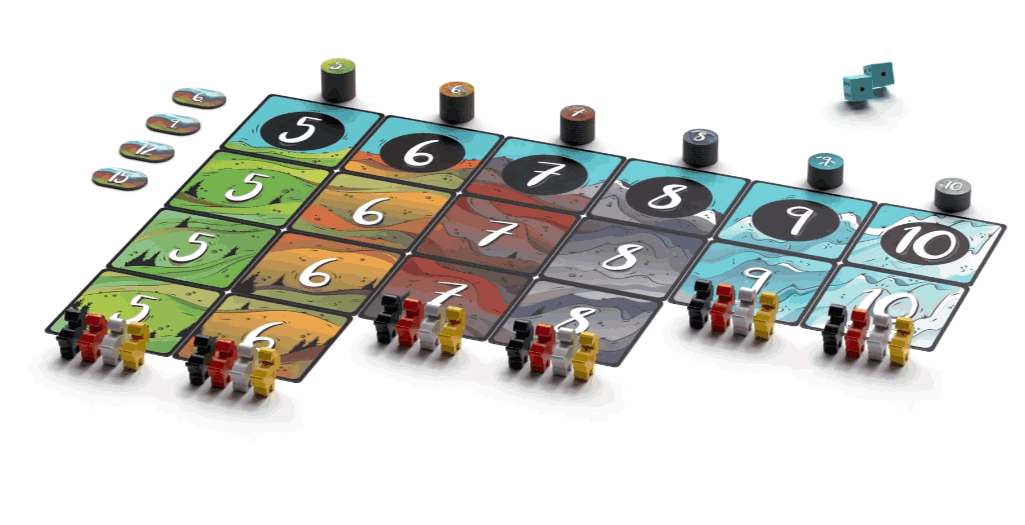
Sequoia games Here, they serve as my bread and butter. I adore everything; it’s quick to learn and easy to play. Though I believe Button Shy has mostly been attempting to give Oink a run for their money on the tiniest games possible—18 cards aren’t a whole lot of extra game, but Button Shy sure knows how to publish interesting stuff—Oink has historically had something of a monopoly on small box games. Regardless, with three titles—Sequoia, GPS, and Mountain Goats—Board Game Tables appears to be making a big impression on the small box game market. I’ll give all three a go and report on my findings!
In Sequoia, you envision yourself ruling the woodlands with the largest trees, only to discover that your rivals share your goals. To beat your rivals to the most desirable woodland spots, you’ll need to use both cunning planning and a little bit of luck because there is a limited quantity. You must overcome your opponents’ treachery even if it may be nothing short of terrifying if you hope to prevail. Will you be able to establish yourself and spread out to seize the most important forest areas?
Setup

Not very much! It is necessary to arrange the numbers 2 through 12 in a circle.
- Discard the dice for each player
- Assign a set of matching tree tokens to every participant
- The first-place tokens should now be shuffled and placed close to each area. Similarly, handle the tokens for second place
- It should be now that you are prepared to begin
GamePlay

Set up by placing woodland cards in a circle numbered two to twelve. Next, randomly assign the first and second tokens to forest cards. Each participant gets dice and trees after choosing a color. Just do this to start.
There are no simpler rules. Players discreetly roll their die at the same time every turn. Make two pairs and lay aside one die. You reveal each die simultaneously with the other players. Now, insert one tree token into a forest tile to match your dice pair’s total number. If you pair the three and five dies, you can place a tree token on card eight. If your dice always roll the same, say “Sequoia!” You can then arrange your dice.
When there are no more trees to place on the tiles, the game is over. The player with the most trees on a card will receive the first-place token on each card. The player with the second-most trees on a card will receive the second-place token on each card. In the event of a tie, remove any player tokens that are not implicated in ties and score the first or second tokens on each card that have no ties as usual.
Until all ties are settled and point tokens are distributed, the player in a tie will play one more turn.
The player with the most points wins the game.
Quality of Game Construction

Dice, cards, and cardboard tokens are the components of the game. The tokens of every hue are punched out neatly and effortlessly after being cut out of various-shaped cardboard that is rather thick. There are five little dice in each color, numbered normally. The cards have a mediocre polish, no core, and are big; because they aren’t shuffled or anything, this might be OK.
Direction of Art
The tokens and the forest cards feature some original artwork. Each of the numbered forest cards features a distinct view from the forest.
Thrill Factor

Everyone is kept on edge by the simultaneous play and dice rolling, and since your strategy will be changing nearly all the time, you’ll need to outsmart the other players as well.
Weight & Age Range
The weight is light, and the age range is 8+. Games last 10 to 15 minutes, and rounds take about a minute. It all comes together to create the ideal sweet spot for this kind of game.
Player Count Variations

Sequoia varies significantly with changes in player counts. Since you can’t cover everything at two, your only option is to hope you can keep your opponent from occupying the high-value areas you’ve selected. You have to find the fine balance between pushing for first place, taking a few seconds, and praying for a tie.
At higher player counts, if you spread yourself too thin, you’ll get eaten alive. Although a cunning player might try to incite rivalry among players to seize the highest-value slot while keeping the lower-value spots for themselves, I don’t think such a tactic will be effective enough to be completely implemented as a guaranteed way to win.
Generally speaking, you might not be aware that you’ve lost a space until it’s difficult for you to take action because everyone is rolling their dice in secret anyhow. Whichever player count you choose will probably depend on your choice because you have to play a little more defensively when there are more players than when there are fewer players.
Even though I liked it a little less on the higher end, there wasn’t enough of a swing for me to state with certainty that I prefer it on the lower end of the player count spectrum. I have appreciated this at two.
Conclusion
Sequoia is a portable and enjoyable light game that you may play anywhere because of its tiny package. The game takes just two minutes to set up, and it takes almost no time at all to master the rules. With up to five players, this is an excellent gateway game that lasts for roughly 10 minutes per game. This game’s artwork is understated yet sophisticated, and it becomes even more exquisite when the trees begin to grow on the cards. Since you throw the dice covertly, we do miss the small screen. However, that wouldn’t fit in such a small box, and hiding it under your palm would be just as simple.
